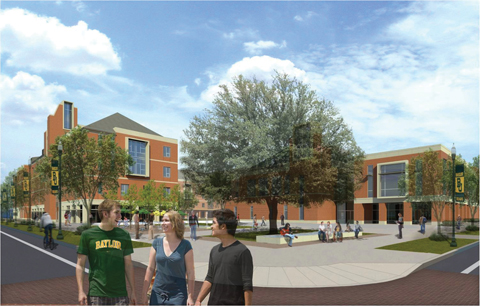Housing Boom
Baylor Regents approve $120 million in capital improvements, including new residential village
At its annual Homecoming meeting, the Baylor Board of Regents approved $120 million in capital improvements, the largest investment in construction on the Baylor campus since the Baylor Sciences Building in 2004. Construction will be financed through the issuance of bonds and will include a new 700-bed residential complex and dining facility on the east side of campus, the renovation of the Marrs McLean Science Building, and Phase 2 of initial construction on academic and research space in the Baylor Research and Innovation Collaborative (BRIC).
The $70 million, 238,715-square-foot East Village Residential Community will consist of two four-story facilities: the 354-bed North Residential Community that will include the Engineering and Computer Science Residential College and the 347-bed South Residential Community that will include the Science and Health Living-Learning Community. The facilities will feature a variety of living spaces, from semi-suites to apartment-style living, as well as study and seminar spaces, student lounge areas, media and game rooms, faculty offices, staff apartments and faculty master apartments. The East Village Residential Community will be built along Bagby Avenue between Second and Fourth streets.
The East Village Residential Community is part of the 21st Century Project of the Association of College and University Housing Officers-International, an innovative national effort to plan a prototype residence hall of the 21st century. Baylor was chosen in 2009 as one of only three higher education institutions to participate in the project.
The East Village project also includes the construction of a 33,170-square-foot, two-story dining hall, which will accommodate more than 500 students on the east side of campus.
The bond issuance approved by Regents also includes $10 million for utility infrastructure improvements to support the development of East Village.
Groundbreaking is expected in January, with construction beginning in March. The new residential community will open to students in August 2013.
Regents also approved $23 million for an extensive renovation of the Marrs McLean Science Building -- built in 1964 -- to provide more academic space for faculty and students. Once the construction is complete, Marrs McLean will house Baylor's School of Education and its departments of curriculum and instruction, educational psychology and educational administration, which will move from their current locations. The move will unite those departments with the department of health, human performance and recreation, which is housed in the neighboring Marrs McLean Gymnasium. The renovation also will expand space for the departments of anthropology and statistics.
As Phase 1 of construction nears completion on the Baylor Research and Innovation Collaborative (BRIC), Regents approved funding for the next phase of construction. Phase 2 will include building out nearly 45,000 square feet of academic and research space for the following Baylor academic components: Center for Astrophysics, Space Physics and Engineering Research, electrical engineering department research, the Center for Spatial Research, Baylor Institute for Air Science and the Hankamer School of Business Innovative Business Accelerator. Phase 2 construction is expected to begin in early spring 2012 and be completed by spring 2013, although some components could be ready by fall 2012.
Phase 2 will bring Baylor's investment in the BRIC to $30 million. Combined with the $9.5 million from the state of Texas, $5 million from McLennan County and the City of Waco and $500,000 from the City of Bellmead, the former General Tire facility will open as the BRIC based on $45 million in combined Baylor, local and state investments in the Central Texas Technology and Research Park.
